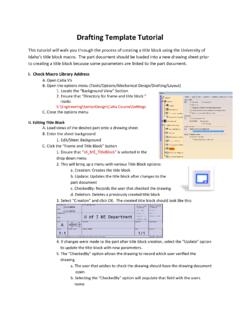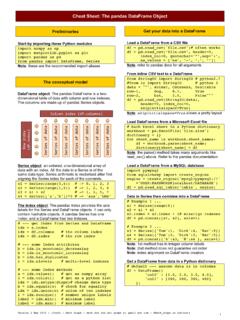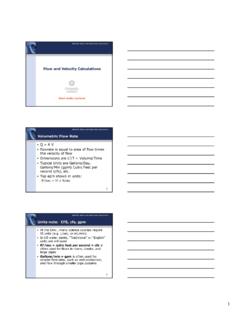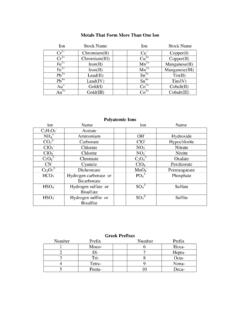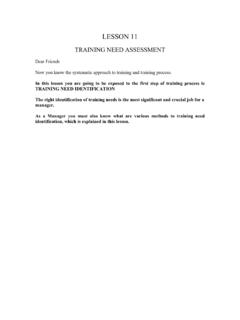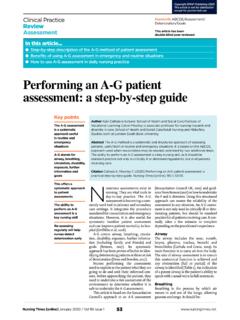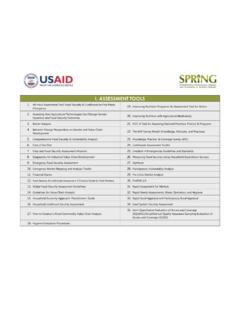Transcription of Assessment Methodology - University of Idaho
1 Faculty Development Series1 Copyright 2003 Pacific CrestDefinitionsKey terminology associated with the Assessment Meth-odology are defined A process of measuring and analyzing a performance or product to provide quality, timely feedback for A qualitative or quantitative measurable characteristic of a A focus area of quality. Evidence A collection of specific qualitative and quantitative data on A specific tool used to obtain of collection What you will use to collect information on the A span that includes all the quality A means for determining the quality level of the MethodologyThe Assessment Methodology consists of four main steps along with a set of sub-steps.
2 The Methodology is as follows:1. Develop guidelines for the assessor to follow when assessing a performance or a the assessee and the assessor should, before the performance:a) Define the purpose of the performance or the ) Define the purpose of the ) Determine what is appropriate to be ) Agree on what should be reported and how it should be reported in the Assessment MethodologyThe Assessment Methodology is a tool to help one better understand the steps needed to do a quality Assessment . By following this process you can learn what you need to know and change what you need to change in order to improve a performance or a product.
3 The discussion and examples of the use of this Methodology are geared toward Assessment of student learning. Much of the terminology used in this Methodology is taken from the Assessment Overview Design the approach to be used for the the assessee and assessor should:a) Inventory a list of possible criteria to be used as part of the ) Choose the criteria from the list in step 2a that best meet the previously established guidelines (Step 1). If appropriate, determine the attributes that indicate quality for each ) For each attribute (or simple criterion), determine the evidence needed to perform the ) Agree on the scale and range to be used in looking at each piece of ) Agree on the method of collection that will be used to collect ) Determine the specific instruments that will be used to collect ) Set up a plan to collect the evidence in a timely Collect and analyze the evidence.
4 The assessor should:a) Collect the evidence agreed upon in Step ) Use the collected evidence to determine and document the strengths and areas to ) Offer feedback during the performance, if appropri-ate and agreed upon beforehand, with the Report the findings to the assessor should:a) Create the Assessment report for the assessee, using the results from Step 1d as a ) Analyze various contributions when evidence of attributes suggests a poor performance or product. Determine what part is due to the evidence collected, the criteria chosen, the use of the product (if appro-priate), and/or the performance or product Daniel K.
5 Apple, Pacific Crest and Marie Baehr, Elmhurst College2 Pacific Crest (630) 737-1067 Copyright 2003 Pacific CrestDiscussion of the Assessment MethodologyDevelop guidelines for the assessor to follow when assessing a performance or a first step in setting up an Assessment is to define the purpose for the performance or product and the purpose for the Assessment . With this information, the person whose performance is being assessed or the group who have developed a product (assessee) can better deter-mine what is important to assess, and the person who is observing the performance or collecting information about the product (assessor) is equipped to give accurate and appropriate determining these two purposes, the two parties should collaborate to determine what is appropriate to assess.
6 This depends on the nature of the activity being performed or the purpose of the product, the skill of the person performing that particular activity or the back-ground of the people who developed the product, the level of Assessment skill on the part of the person assess-ing, and the assessor s knowledge of what he or she is assessing. Finally, the assessee and assessor must decide on the form and content of the Assessment report, what the report should include and how it should be the approach to be used for the designing an approach for Assessment , both parties should collaborate to generate a list of possible criteria that could be used by the assessor to give feedback to the assessee.
7 From this list, both should agree and select the most important criteria that best fit within the guidelines from the first step in the Methodology . In most cases, this list should contain no more than four criteria. For each chosen criterion, determine appropriate attributes to look for during the performance or in the product. Note that in some cases where the Assessment is more nar-rowly focused, the criterion may be manageable enough without defining attributes. It is important for both the assessor and the assessee to discuss how evidence will be collected, the expected range the assessor might find when collecting evidence, and the scale the assessor will use when collecting the evidence.
8 Typically the range will be set by the assessee s abilities while the scale will be set by the assessor s abilities. Finally, the assessor and the assessee should agree on a plan to collect the needed information as well as the specific instruments that will be used to collect the desired of the keys to learning how to assess is to start simple. Often the evidence you collect for analyzing quality can be measured on a basic scale. For example, if you are asked to assess an oral presentation, one of the attributes could be eye contact. A veteran assessor might collect evidence by determining the eye contact on a scale of 1 to 10.
9 However, a novice assessor could use a scale of none, some, lots. Both scales elicit information to create constructive is important for the assessor and assessee to agree on the method of collection. This method could be in the form of observing, looking at test results, filling out check lists, or collecting questionnaires. Note that the method of collection is more general than the particular instrument chosen. The assessee needs to be a part of the discussion of choosing the method, but the assessor alone chooses the particular instrument to use, the particular method, once the general method is mutually satisfactory to both the assessor and assessee should also determine HOW the evidence can be collected in a timely and analyze the the design is in place, it is up to the assessor to collect the agreed upon evidence.
10 Once the evidence is collected, the assessor must make sense of it by look-ing at what it says about the attributes and criteria. This information can then be used to document strengths and areas to improve. The process itself can help the assessor with the case where the Assessment plan includes the col-lection of evidence during the performance, rather than waiting for the final Assessment report, the assessee may ask the assessor for feedback during the performance, called real-time feedback or authentic Assessment . If appropriate to the situation and agreed upon prior to the start of the performance, the assessor may offer feedback (to the assessee) during the performance.

